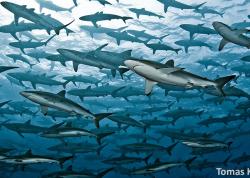Big Animal Encounter: Humpback Whales
Humpback Whales at the Socorro Islands
An amazing underwater photography encounter with the giants of the sea
Text and Underwater Photos by Marianne C. Kehr
It was early April when I packed my bags for the trip from my home in Bucks County, PA. My destination: Cabo San Lucas, Mexico. Specifically, the Revillagigedos Archipelago, commonly known as the Socorro Islands, which are located in the eastern Pacific Ocean at the tip of the Baja peninsula. The archipelago consists of four islands; Socorro, San Benedicto, Clarion, and Roca Partida. These islands have been compared to the Galapagos Islands in Ecuador or Cocos Island in Costa Rica because of the big animal encounters they provide.
See also: Comparing the Diving in Socorro, Cocos and Galapagos
This is where I hoped to have my very own big animal encounter, and see the majestic humpback whales in all their glory! To add to the adventure, this would be my first trip on a Socorro liveaboard: the Solmar V. The trip was part of an Underwater Photography Workshop on the Solmar V that is held annually with Bonnie Pelnar.

Mother and her calf. Olympus E520 in an Ikelite housing, with a 11-22 mm lens, F3.5, 1/125, ISO 200
The crew greeted everyone with heart-warming smiles, and I knew I was going to be in very good hands. The crew was professional and assisted us every step of the way. The accomodations were very nice, and everyone had plenty of room. The meals were wonderful, and I thought the after-dinner dessert was especially delicious!

Up-close and personal with a calf. F5, 1/80, ISO 200
The Dives
The diving was conducted from the stern of the Solmar V and from their zodiacs. The zodiacs allowed us to get as close as possible to the whales without disturbing them. We prepped our cameras for the whale encounters, which involved removing our strobes, since the flashes would startle the whales. Therefore, all of my humpback whale underwater photos were shot in ambient light near the surface.

The whales stayed with us for two days, which allowed us to get amazing shots, like this one.

The mothers stay close to their calves and keep a watchful eye on them while they gain strength.
My Settings for the Underwater Photography
I shot primarily in Aperture Priority. This allowed me to focus on getting the depth of field I wanted, while letting the camera do the rest.
My images were all shot in RAW instead of JPG, to give me the maximum amount of post-processing freedom.
I loved my 11-22 mm lens for this experience because it was wide enough to capture the scene, no matter what focal length I set. Publishers note: 11-22mm on an Olympus E520 is equivalent to 14-28mm on a cropped sensor dSLR, or 22-44mm on a full-frame dSLR - Scott.

Snorkellers position themselves to get "the shot" while swimming with the giants.

A calf breaches after watching her mother. Mothers will teach their newborns this, and other valuable lessons before heading back to the Alaskan waters. F11, 1/250, ISO 200

A mother and her calf glide off into the blue. It was a wonderful experience!
Best time to go
Typically late January through early April is the optimal time to see them as the humpbacks migrate from Alaskan waters to the Socorro Islands to calve and breed.
Book Your Trip to Socorro

View availability of some of the best liveaboards in Socorro
Further Reading
- Wide-angle photography tips
- Diving Socorro by Bonnie Pelnar
- Good blue color in underwater wide-angle shots
- Ambient light photography tutorial
- Diving with Humpback Whales in Tonga, with Underwater Photo tips
- Diving with Humpback Whales in Silver Bank, Dominican Republic
RECOMMENDED ARTICLES
SUPPORT THE UNDERWATER PHOTOGRAPHY GUIDE:
The Best Service & Prices on u/w Photo Gear
 Visit Bluewater Photo & Video for all your underwater photography and video gear. Click, or call the team at (310) 633-5052 for expert advice!
Visit Bluewater Photo & Video for all your underwater photography and video gear. Click, or call the team at (310) 633-5052 for expert advice!
The Best Pricing, Service & Expert Advice to Book your Dive Trips
 Bluewater Travel is your full-service scuba travel agency. Let our expert advisers plan and book your next dive vacation. Run by divers, for divers.
Bluewater Travel is your full-service scuba travel agency. Let our expert advisers plan and book your next dive vacation. Run by divers, for divers.





























